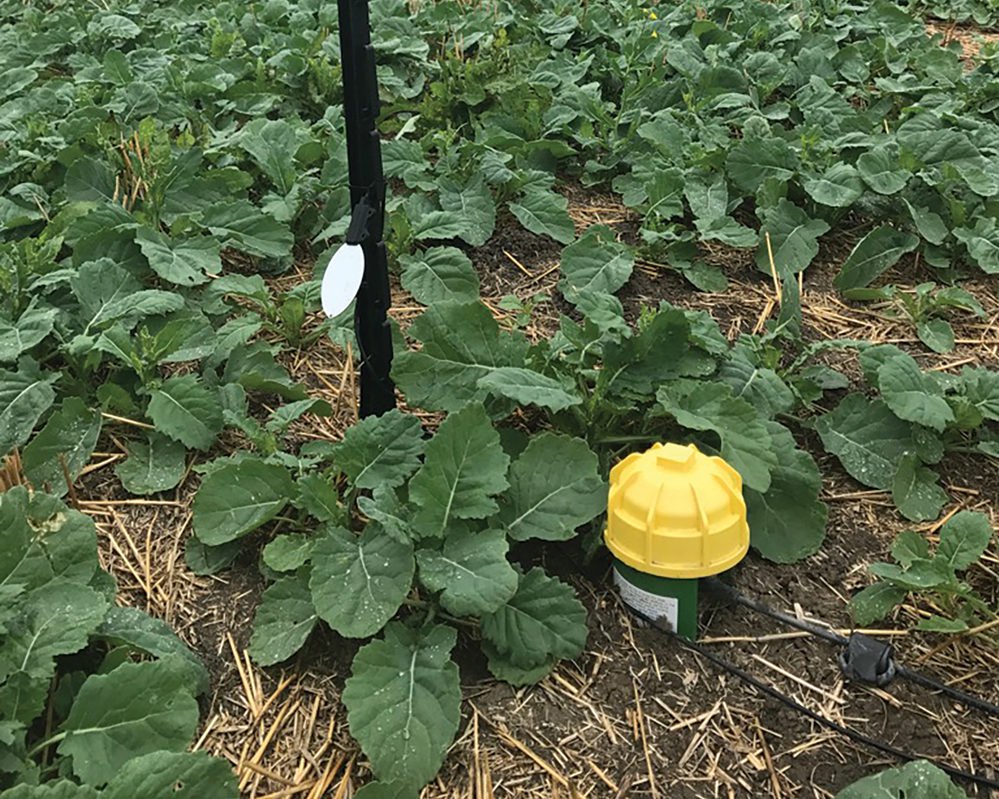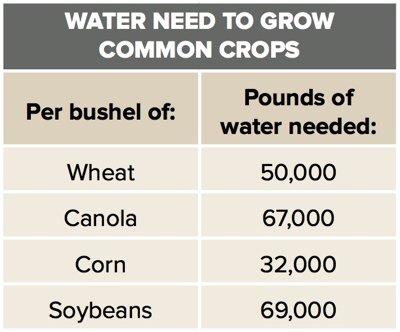New app and service gives producers a better handle on moisture

solar intensity and wind speed. The weather station also ties into the moisture probe which is installed near the steel post at right.
Photo: Crop Intelligence
Since technology so far can’t make it start or stop raining on dryland farms, it is obviously important to make the most efficient use of moisture that is available during the growing season. But how much moisture do or will you have for that crop?
Depending on the year and location, spring seedbed soil moisture can range from bone dry, to saturated. And with sometimes-wacky weather patterns who knows how much timely rain will come during the year to carry that crop through. How do you plan your fertility and yield expectations around that variability?
A relatively new service for Western Canadian farmers can’t make it rain, or even offer any guarantees but it is using field technology and analysis of long-term weather data to help farmers make the always sought after “more informed decisions.”
Crop Intelligence is a service and app launched by South Country Equipment in Saskatchewan. Crop Intelligence started with and maintains strong John Deere roots, but the service for measuring and predicting available growing season moisture is available to all producers regardless of their equipment colour.
Crop Intelligence offers producers, usually working with a trained dealer rep or consulting agronomist, three important pieces of information. The first part is on-farm weather stations with soil moisture probes. The probes provide a starting point at the beginning of the crop year, measuring of how much water is in the soil profile — the top 40 inches of soil. Second, as rain falls and the crop grows the system provides a daily measure of moisture levels. Along with that, the service has 30-years of analyzed weather data for Western Canada that can estimate how much moisture you can reasonably expect to have available for the coming growing season.
“The app and service is about understanding and learning how to determine the water-driven yield potential on your farm,” says Ryan Hutchison, integrated solutions manager with South Country Equipment. Hutchison developed the Crop Intelligence service, along with agronomists Bonnie Mandziak and Kendall Gee at South Country, and Elston Solberg, formerly with AgriTrend Agrology, now with Earth Dirt Soil consulting services.

soil profile to monitor soil moisture on a live, daily basis. It’s continuous readouts to the app will show how soil moisture changes —
up with rainfall or down as the crop grows and roots penetrate deeper). The small white tab on the post is a leaf wetness sensor which all feeds information into system.
Photo: Crop Intelligence
Crop Intelligence worked with clients with about 400 moisture probes installed across Western Canadian farms in 2018 and they expect that will increase to about 1,000 sites this coming year.
The app
In the simplest terms, with the soil moisture probe in the ground providing live daily soil moisture readings, combined with the 30-year average of potential precipitation in the area, the farmer can decide if there is a greater yield potential available. The app is designed to work with crops that are suited for top-dressing operations such as most cereals and canola. It would not likely be used with most pulse crops.
As an example, Hutchison describes a farmer who seeded canola in the spring with enough fertilizer to target a 45-bushel yield. “The crop is growing well, roots are developing deeper in the soil and as the spring progresses, the soil moisture probe is showing there is still four to five inches of moisture in the soil profile and the 30-year weather data is showing on average his area could expect eight or 10 inches of moisture over the growing season. So, with everything looking favourable does the farmer want to top dress fertility and other inputs to hopefully capture another 15 to 20 bushels of yield?”
If everything looks favourable top dressing may be viable option, but Hutchison says there are also times where the best decision may be to do nothing further. For example, if there is moisture deeper down, but the top few inches of the seedbed are dry and the historical data shows a dry spell ahead, it may not make sense to top dress with more nutrients if there may not be moisture to move those nutrients into the soil.
While moisture probes are common in irrigation areas, they aren’t widely used in dryland farming. Hutchison says, even during a dry year, the probes can show how soil moisture can replenish itself. He recommends installing probes right after seeding and leaving them in place until freeze up.
Hutchison points to moisture readings on a farm near Moosomin as an example. In the spring of 2017, the moisture probe showed soils were full of moisture, almost saturated. Crops were seeded, but — the good news —it didn’t rain for more than six weeks. By freeze up in the fall, the moisture probe showed the crop had depleted virtually all crop-available moisture. When probes were installed in the spring of 2018, soil moisture levels were almost back to where they were in the spring of 2017. Snowmelt and ground water reserves had replenished moisture.
Hutchison says there are three basic components to the Crop Intelligence system.
- The producer needs to buy, rent or lease the weather station and moisture probe. And at the moment two systems (platforms) are compatible with the Crop Intelligence software — one is the John Deere Field Connect weather station and moisture probe, the other is the Austrian-made Pessl equipment that uses a Centek. These weather stations and probes will cost from $3,000 to $9000.
- Although the weather stations aren’t complicated, Crop Intelligence recommends farmers line up a service such as a dealer representative or a crop consultant to install and remove them.
- Producers interested in the service need to pay an annual Crop Intelligence subscription fee for each weather station and probe.
Every inch of water increases yield potential

Elston Solberg, agronomy consultant working with Crop Intelligence, says knowing how much water is available in the soil can help farmers make decisions.
“You ask farmers about how much moisture it takes to grow a crop, or how much moisture they have in their soil and most really don’t know,” says Solberg, who often speaks to producer groups about moisture being one of the most important and yet often forgotten nutrients on the farm.
Solberg describes soil moisture as the pivot point in balancing the effectiveness of all other nutrients. If there is sufficient moisture, the nitrogen, potash, potassium, sulphur and micronutrients can be more efficiency used by the crop.
Looking at it from another perspective, research has shown that under good environmental conditions, for each 25 mm (1 inch) of water used, wheat produces five to seven bushels/acre, barley produces seven to nine bushels/acre and canola produces five to six bushels/acre.
“If water is in balance with the rest of the nutrients (fertility) those nutrients can be better used by the crops and perhaps we can grow a target yield on 40,000 lbs of water per bushel for wheat, or 57,000 lbs of water for canola or 20,000 pounds for corn,” says Solberg.
Knowing how moisture is available during the growing season can help farmers make decisions. Solberg says it can also be a tool in reducing inputs.
“A dry year in many parts of Saskatchewan in 2017 was a good example,” says Solberg. “The moisture wasn’t there, the canola yield potential wasn’t there so producers didn’t spray for sclerotinia because it wouldn’t produce a return, so that saved then a $25 or $30 per acre input cost.”
Article source: https://www.grainews.ca/2019/04/02/new-app-and-service-gives-farmers-a-better-handle-on-moisture/
By: Lee Hart
Field Editor
April 2, 2019
